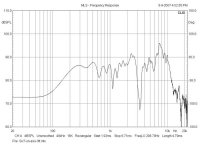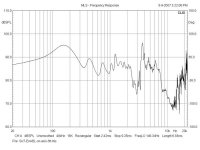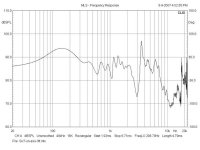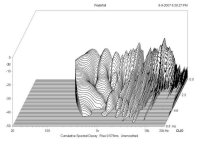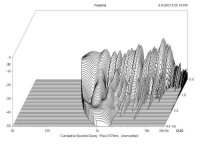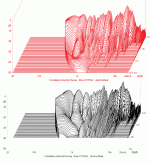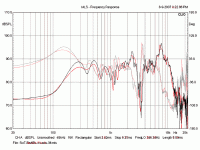Standard Cone Waterfall
Finally, the standard cone waterfall. Note that there is a difference in the time scale between this graph and the EnABLed cone. My mistake, but you can see the difference easily.
Now would someone look at these and tell me why I hear any difference. I printed them up, held each one up to the light with its Standard/EnABL cone up to the light to look for significant differences, and could not find anything of note.
Have some fun with these! I guess I should post some smoothed off-axis graphs so you can camper these to standard manufacturers graphs.
Finally, the standard cone waterfall. Note that there is a difference in the time scale between this graph and the EnABLed cone. My mistake, but you can see the difference easily.
Now would someone look at these and tell me why I hear any difference. I printed them up, held each one up to the light with its Standard/EnABL cone up to the light to look for significant differences, and could not find anything of note.
Have some fun with these! I guess I should post some smoothed off-axis graphs so you can camper these to standard manufacturers graphs.
Attachments
Re: Standard Cone Waterfall
Easy, your ear != machine 🙂
Bud - have you tried this process on say.... a Celestion V30 (or knockoff of)?
Cheers!
Jon Ver Halen said:Now would someone look at these and tell me why I hear any difference.
Easy, your ear != machine 🙂
Bud - have you tried this process on say.... a Celestion V30 (or knockoff of)?

Cheers!
Re: Standard Cone Waterfall
To do a really good compare, the scales do need to be the same. Also if you save these files as low-bit gifs they will be easier to manipulate (& smaller file size)
Here is the waterfalls -- all i could do is chop off the EnABLEd one (black) at the same place as the stock
(It would also make things more obvious if Clio was able to do waterfalls with a time scale of periods instead of sec)
On the whole the EnABLEd cone doesn't look as good in these waterfalls as the stock one -- particularily above 1k.
dave
Jon Ver Halen said:Finally, the standard cone waterfall. Note that there is a difference in the time scale between this graph and the EnABLed cone. My mistake, but you can see the difference easily.
To do a really good compare, the scales do need to be the same. Also if you save these files as low-bit gifs they will be easier to manipulate (& smaller file size)
Here is the waterfalls -- all i could do is chop off the EnABLEd one (black) at the same place as the stock
(It would also make things more obvious if Clio was able to do waterfalls with a time scale of periods instead of sec)
On the whole the EnABLEd cone doesn't look as good in these waterfalls as the stock one -- particularily above 1k.
dave
Attachments
And FR & Phase. EnABLE is black, the "grayed" curves are phase. Be nice to see off-axis curves where we would have flat as a reference. Not much to grab between these 2, again if one had to choose, stock looks a tiny bit smoother (ie in most cases peaks & valleys have slightly less amplitude)
dave
dave
Attachments
Wow....
What a lot of effort you guys are putting into this!
Jon, you have discovered the root of my despair over this process. The only test I have seen run, that ever showed any objective differences, with current measurement forms, were done by Larry Arnst, using a cheap phenolic ring paper cone tweeter and a mic distance of 1 inch. Those are shown in the paper posted here.
http://www.positive-feedback.com/Issue21/standingwaves.htm
I had actually given up on the EnABL treatment and was in the process of forgetting about it, when this forum caught my eye and the Walsh thread attracted me, because I had owned a pair of Ohm F's and the EnABL pattern was developed on them, not on a conventional driver.
Your test results absolutely mirror mine. In addition I could find no meaningful differences in distortion plots, at a meter distance, regardless of the type, odd or even, or remove from initial tone, 3rds, 4ths etc.
Dan Wiggins is investigating the EnABL process right now. He has had some results that encourage him but has not shared them with me as of yet. But, if anyone can figure out what to measure and how, it will likely be him. Sonngsc has also made a couple of excellent discoveries and posted them on this thread. But, even with his testing, the only change, other than the suppression of systemic ringing at one frequency, was in the amount of phase change available with the addition of pattern rings. Everything else remained essentially the same.
Thank you for testing and reporting Jon, you have confirmed what others have found. The process works, and does so on drivers already at the highest levels of performance, without giving us a hint about what sort of test might actually reveal, objectively, what is going on. I don't scratch my head about this anymore, thirty years of scratching is not a good thing to do, but I am very pleased to have some help and corroboration, about the peculiarities of this pattern on speakers.
t-head,
Thank you for posting your results. What you describe is quite familiar to me, though the 100 hours, for everything to settle is not my experience. I must admit that my reference speakers have many thousands of hours on them, so, that part of the aging process does not show up here. I do like your enthusiastic descriptions. When the music is uncovered and made visceral, it always ignites colorful responses.
I would encourage all of you DIYers to follow t-head's or Planet 10 Dave's patient approach and obtain the kit needed to EnABL process your own drivers, just to see what the removal of standing wave corruption can sound like, while measuring as though it does not exist and no changes have been wrought.
Bud
What a lot of effort you guys are putting into this!
Jon, you have discovered the root of my despair over this process. The only test I have seen run, that ever showed any objective differences, with current measurement forms, were done by Larry Arnst, using a cheap phenolic ring paper cone tweeter and a mic distance of 1 inch. Those are shown in the paper posted here.
http://www.positive-feedback.com/Issue21/standingwaves.htm
I had actually given up on the EnABL treatment and was in the process of forgetting about it, when this forum caught my eye and the Walsh thread attracted me, because I had owned a pair of Ohm F's and the EnABL pattern was developed on them, not on a conventional driver.
Your test results absolutely mirror mine. In addition I could find no meaningful differences in distortion plots, at a meter distance, regardless of the type, odd or even, or remove from initial tone, 3rds, 4ths etc.
Dan Wiggins is investigating the EnABL process right now. He has had some results that encourage him but has not shared them with me as of yet. But, if anyone can figure out what to measure and how, it will likely be him. Sonngsc has also made a couple of excellent discoveries and posted them on this thread. But, even with his testing, the only change, other than the suppression of systemic ringing at one frequency, was in the amount of phase change available with the addition of pattern rings. Everything else remained essentially the same.
Thank you for testing and reporting Jon, you have confirmed what others have found. The process works, and does so on drivers already at the highest levels of performance, without giving us a hint about what sort of test might actually reveal, objectively, what is going on. I don't scratch my head about this anymore, thirty years of scratching is not a good thing to do, but I am very pleased to have some help and corroboration, about the peculiarities of this pattern on speakers.
t-head,
Thank you for posting your results. What you describe is quite familiar to me, though the 100 hours, for everything to settle is not my experience. I must admit that my reference speakers have many thousands of hours on them, so, that part of the aging process does not show up here. I do like your enthusiastic descriptions. When the music is uncovered and made visceral, it always ignites colorful responses.
I would encourage all of you DIYers to follow t-head's or Planet 10 Dave's patient approach and obtain the kit needed to EnABL process your own drivers, just to see what the removal of standing wave corruption can sound like, while measuring as though it does not exist and no changes have been wrought.
Bud
Has there not been one dissenting voice through this whole thread? Hasn't anyone questioned the "science"? Or have they all been weeded out and sent to Texas?
This plays like an infomercial - with a stacked audience.
Model airplane paint, toothpaste, felt pads, eye of newt.
This plays like an infomercial - with a stacked audience.
Model airplane paint, toothpaste, felt pads, eye of newt.
MJL21193 said:Has there not been one dissenting voice through this whole thread? Hasn't anyone questioned the "science"? Or have they all been weeded out and sent to Texas?
This plays like an infomercial - with a stacked audience.
Model airplane paint, toothpaste, felt pads, eye of newt.
I completely agree with you in your disgust .........
old pooftah Bud selling that weed like mad........
seems that never is too late for old weasels


John / tade / Zen Mod (et al others)
if any of the above posts are meant in jest, OK - cute.
if not, when have you had the opportunity to compare a stock to EnAbl'd driver, or listen to the difference that Bud's EP tails make, in a system with which you are intimately familiar?
There is a growing audience who have, and lack of easily compartmentalized "scientific" explanations be damned, these things not only "make a difference" (measurable yet or not), but to those who have heard them (many with substantial experience), the difference has been generally judged as a definite improvement.
In my own words, I'd describe each as increasing resolution of low level detail and overall coherency; and yes the affects are accumulative.
Until you can hear any "new" thing for yourself, an open mind wouldn't hurt.
if any of the above posts are meant in jest, OK - cute.
if not, when have you had the opportunity to compare a stock to EnAbl'd driver, or listen to the difference that Bud's EP tails make, in a system with which you are intimately familiar?
There is a growing audience who have, and lack of easily compartmentalized "scientific" explanations be damned, these things not only "make a difference" (measurable yet or not), but to those who have heard them (many with substantial experience), the difference has been generally judged as a definite improvement.
In my own words, I'd describe each as increasing resolution of low level detail and overall coherency; and yes the affects are accumulative.
Until you can hear any "new" thing for yourself, an open mind wouldn't hurt.
chrisb said:............Zen Mod ............
.................
http://www.diyaudio.com/forums/showthread.php?postid=1272622#post1272622

just for illustration how Bud is bad
chrisb said:
There is a growing audience who have, and lack of easily compartmentalized "scientific" explanations be damned,
Mass hysteria: "Also called collective hysteria or collective obsessional behavior, is the socio psychological phenomenon of the manifestation of the same or similar hysterical symptoms by more than one person. They then may believe they are suffering from a similar disease or ailment."
The "tests" that have been run (on suspect instrumentation) show little difference, in fact the most recent show this treatment to be detrimental. The very problem that this treatment is meant to fix, is shown to be worse than untreated.
Oh, but ignore that, because it sounds better.😉
I make the same case here as I did for the ground side electron holding cell: Why haven't the big, sophisticated speaker manufacturers stumbled on this before? Not enough funds in the R&D budget?
Hi John,
Actually a number have questioned the "science". Some have even done some science. The weird thing is it seems we don't actually have a tool, or tools to pick out the events, that the EnABL process and distributed capacitance cables and electron pools are addressing, out of whatever back ground noise they are hiding in.
I have offered. on another thread, some free "fruits of my loom" if someone with skill, equipment and technique would take just the electron pools and figure out what is going on and how to find whatever portion of a normal poured ground plane, the embarrassing pieces of wire are representing. No takers to date, not a peep, except maybe, from a fellow in New Zealand, who has extremely good ground planes, correctly implemented, and found no worth in the wire "tails" whatsoever. This is encouraging, because as nice as it is to be patted on the back and told "good job" I really want to know what the heck is going on .
And then there are the audio transformers. Less than a third of the exciting current that by calculation must exist. No measurable zero crossing distortion, no measurable reminince, but still with a hysteresis curve, though no longer a square cornered one. A dielectric circuit that has been proven to be a lumped sum parameter, that, when actually picked apart, allows coil construction that provides ruler flat phase to 30 kHz, at full power, in a 300 watt RMS amplifier. The frequency response is flat to 40 k and the distortion above 250 Hz drops to unfindable by an Audio Precision model one tester. And all of this using regular commercial materials, no special amorphous alloys, no Teflon dielectrics, no C core, just E/I core and bobbins. I am a magnetician, this is my business, and it scares me that the only two theories that I and my peers have come up with show the common derivations of Maxwell's field theories to be flawed. Not the theories themselves, vague as they are, but the engineering derivations, applied to hard metals, to get results.
So, I agree with you John, and I would love for some people smarter than I am to dig into this stuff. Not because I get to feel good about myself, I already do, but because I think there are some real benefits to be discovered and if they can be brought out to a larger array of problems, than I am capable of contemplating, we might all benefit. Maybe even a lot. This is the reason I have posted and been as transparent as I know how to be.
So, if you know some skilled folks who might like to turn over a rock or two, please, have them join in and poke very hard at what is being presented.
Bud
Actually a number have questioned the "science". Some have even done some science. The weird thing is it seems we don't actually have a tool, or tools to pick out the events, that the EnABL process and distributed capacitance cables and electron pools are addressing, out of whatever back ground noise they are hiding in.
I have offered. on another thread, some free "fruits of my loom" if someone with skill, equipment and technique would take just the electron pools and figure out what is going on and how to find whatever portion of a normal poured ground plane, the embarrassing pieces of wire are representing. No takers to date, not a peep, except maybe, from a fellow in New Zealand, who has extremely good ground planes, correctly implemented, and found no worth in the wire "tails" whatsoever. This is encouraging, because as nice as it is to be patted on the back and told "good job" I really want to know what the heck is going on .
And then there are the audio transformers. Less than a third of the exciting current that by calculation must exist. No measurable zero crossing distortion, no measurable reminince, but still with a hysteresis curve, though no longer a square cornered one. A dielectric circuit that has been proven to be a lumped sum parameter, that, when actually picked apart, allows coil construction that provides ruler flat phase to 30 kHz, at full power, in a 300 watt RMS amplifier. The frequency response is flat to 40 k and the distortion above 250 Hz drops to unfindable by an Audio Precision model one tester. And all of this using regular commercial materials, no special amorphous alloys, no Teflon dielectrics, no C core, just E/I core and bobbins. I am a magnetician, this is my business, and it scares me that the only two theories that I and my peers have come up with show the common derivations of Maxwell's field theories to be flawed. Not the theories themselves, vague as they are, but the engineering derivations, applied to hard metals, to get results.
So, I agree with you John, and I would love for some people smarter than I am to dig into this stuff. Not because I get to feel good about myself, I already do, but because I think there are some real benefits to be discovered and if they can be brought out to a larger array of problems, than I am capable of contemplating, we might all benefit. Maybe even a lot. This is the reason I have posted and been as transparent as I know how to be.
So, if you know some skilled folks who might like to turn over a rock or two, please, have them join in and poke very hard at what is being presented.
Bud
I think a few of us are trying to figure out a relation between the pattern and various cone material. I don't like snake oil type of things like many of others here, but just trying to throw in negative comments without anything to contribute the clarification really is not respectfull.MJL21193 said:Has there not been one dissenting voice through this whole thread? Hasn't anyone questioned the "science"? Or have they all been weeded out and sent to Texas?
This plays like an infomercial - with a stacked audience.
Model airplane paint, toothpaste, felt pads, eye of newt.
I believe the pattern as it is works well with some soft cone material, but as stiffer cone material is used, the pattern as is is less effective. My current understanding is that the patterns themselves changes the angle in which the vibration wave enters the surround. This produces two effects: 1) it increases the path of energy dissipation through the surround, 2) the reflection is dispersed in a way that cone breakup modes should be reduced. I thinif Dan is working on with a structural analysis system, he may find this out and more appropriately alter the pattern for different material.
Re: EnABL frequency response
Jon, I kind of get the feeling your are still getting some reflections in your data. If you used MLS signals for testing, might try reduing window size to see if the camel humps on the left side goes away.Jon Ver Halen said:OK, repeating myself. On axis, 3' away, no smoothing. Lowthers are much better when off axis, but these measurements were meant to show the difference between EnAbLD and standard. So, in essence, I am saying these are ugly and I know it.
Because it's just as easy to spend less R&D to make more money. Just go to the stores and see how critical the consumers are about sound and how they choose.MJL21193 said:
Mass hysteria: "Also called collective hysteria or collective obsessional behavior, is the socio psychological phenomenon of the manifestation of the same or similar hysterical symptoms by more than one person. They then may believe they are suffering from a similar disease or ailment."
The "tests" that have been run (on suspect instrumentation) show little difference, in fact the most recent show this treatment to be detrimental. The very problem that this treatment is meant to fix, is shown to be worse than untreated.
Oh, but ignore that, because it sounds better.😉
I make the same case here as I did for the ground side electron holding cell: Why haven't the big, sophisticated speaker manufacturers stumbled on this before? Not enough funds in the R&D budget?

Looking at Jon's data, I really cannot tell whether it's better or worse. Perhaps someone and elaborate on that?
BudP said:
Actually a number have questioned the "science". Some have even done some science. The weird thing is it seems we don't actually have a tool, or tools to pick out the events, that the EnABL process and distributed capacitance cables and electron pools are addressing, out of whatever back ground noise they are hiding in.
Who needs scientific testing when you can actually hear the difference? Everyone on this thread so far hears a remarkable difference. How can that be disputed?
If testing (unbiased) were to reveal that the process makes no difference at all, it would still be a matter of hearing the improvement.
- Status
- Not open for further replies.
- Home
- Loudspeakers
- Multi-Way
- EnABL Processes
